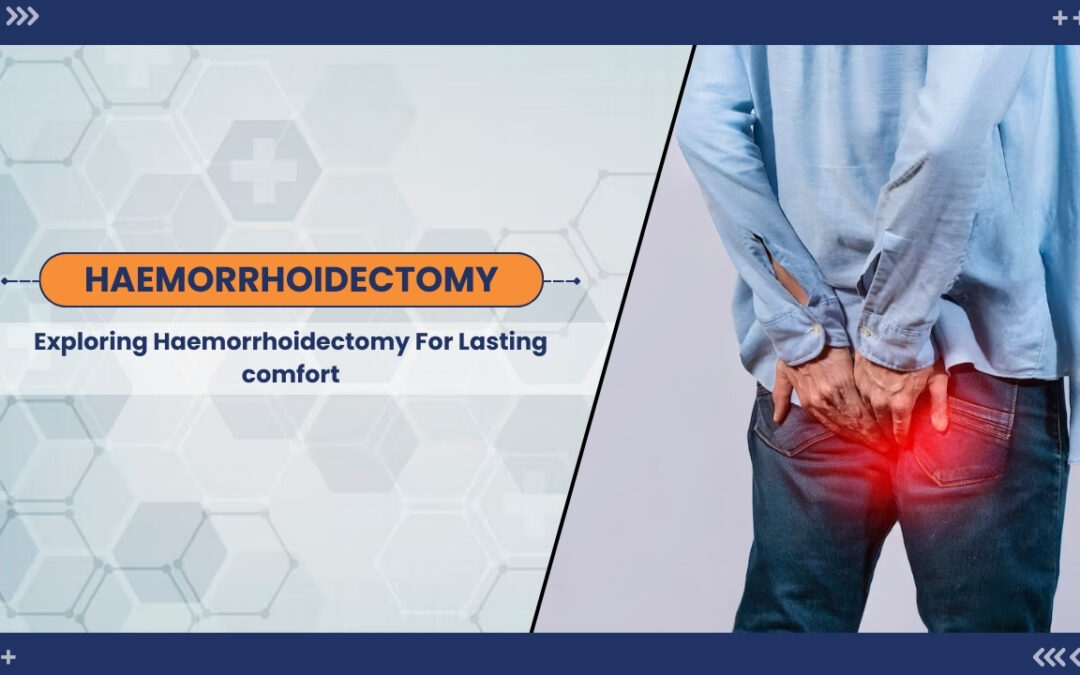Understanding Haemorrhoidectomy:
Haemorrhoidectomy serves as a surgical solution for the relief of hemorrhoidal discomfort, offering lasting respite from pain and irritation. In this blog, we unravel the intricacies of the procedure, exploring both traditional and modern techniques. From the importance of accurate diagnosis to the choice between open surgery and less invasive approaches, our guide navigates through key considerations. Emphasizing the significance of postoperative care and recovery, we empower readers with insights into managing and preventing recurrence. Dive into the world of Haemorrhoidectomy with us, ensuring an informed approach to reclaiming comfort and enhancing overall well-being. Learn how this procedure can be a transformative step towards a life free from the discomfort of hemorrhoids, allowing you to stride confidently towards lasting relief and optimal health.
Causes, Symptoms, and Risk Factors of Haemorrhoids:
Causes of Haemorrhoids:
- Chronic constipation and straining during bowel movements.
- Prolonged sitting or standing.
- Obesity and a sedentary lifestyle.
- Pregnancy and childbirth.
Symptoms of Haemorrhoids:
- Rectal bleeding during bowel movements.
- Itching, irritation, and discomfort in the anal region.
- Swelling or lumps around the anus.
- Pain or discomfort during bowel movements.
Risk Factors for Haemorrhoids:
- Age, as the risk increases with advancing age.
- Family history of haemorrhoids.
- Chronic conditions like liver cirrhosis.
- Low-fiber diet and inadequate fluid intake.
Demystifying Haemorrhoids:
- Haemorrhoids result from swollen blood vessels in the rectum or anus.
- Straining during bowel movements contributes to their development.
- Understanding the causes, symptoms, and risk factors is crucial for early intervention.
- Lifestyle modifications, dietary changes, and medical treatments can alleviate symptoms.
When is Haemorrhoidectomy Recommended? Indications and Considerations
Discovering when Haemorrhoidectomy is recommended involves understanding specific indications and considerations. This surgical intervention is typically advised under the following circumstances:
1. Persistent Symptoms:
- When conservative treatments fail to alleviate persistent and severe haemorrhoidal symptoms.
2. Large or Prolapsed Haemorrhoids:
- In cases where haemorrhoids are significantly enlarged or have prolapsed, causing discomfort.
3. Chronic Bleeding:
- When there is recurrent or chronic bleeding during bowel movements, indicating a need for more definitive intervention.
4. Thrombosed Haemorrhoids:
- In situations where blood clots form within external haemorrhoids, causing acute pain and swelling.
Considerations:
- Patient’s overall health and medical history.
- Severity of symptoms and impact on daily life.
- Evaluation of potential risks and benefits.
Understanding these indications and considerations is pivotal for individuals contemplating Haemorrhoidectomy, ensuring a well-informed decision for effective and lasting relief from haemorrhoidal discomfort.
Types of Haemorrhoids:
Haemorrhoids, also known as piles, are classified into two main types based on their location:
Internal Haemorrhoids:
-
- Located inside the rectum where there are fewer pain-sensing nerves, often making them less symptomatic.
- Symptoms may include bleeding during bowel movements, protrusion during straining, or mucus discharge.
- Graded from I to IV based on severity, with higher grades indicating more severe prolapse.
External Haemorrhoids:
-
- Develop under the skin around the outside of the anal opening where there are more pain-sensing nerves.
- Typically more symptomatic, causing pain, itching, and swelling.
- Thrombosed external haemorrhoids occur when blood clots form, leading to increased pain and swelling.
Surgical Techniques: Exploring Different Approaches to Haemorrhoidectomy
Haemorrhoidectomy as we explore diverse surgical techniques for effective hemorrhoid removal. Two primary approaches dominate this landscape:
1. Traditional Open Haemorrhoidectomy:
- Involves a surgical incision to remove hemorrhoids.
- Suitable for larger or more severe hemorrhoidal cases.
2. Minimally Invasive Techniques:
- Includes procedures like Stapled Haemorrhoidopexy (PPH) and Transanal Haemorrhoidal Dearterialization (THD).
- Characterized by less tissue removal, reduced pain, and quicker recovery.
Understanding these surgical techniques empowers individuals to make informed decisions about their treatment. Whether opting for the time-tested traditional approach or embracing the benefits of minimally invasive methods, our blog unravels the nuances, offering insights into the varying surgical landscapes of Haemorrhoidectomy for a more informed and confident journey towards relief and recovery.
Managing Pain After Haemorrhoidectomy: Tips for a Comfortable Recovery
Navigating post-Haemorrhoidectomy recovery with comfort in mind involves effective pain management strategies. Consider these tips for a smoother healing process:
1. Medication Adherence:
- Follow prescribed pain medications as directed by your healthcare provider.
2. Ice Packs:
- Apply ice packs to the anal area to reduce swelling and alleviate discomfort.
3. Sitz Baths:
- Embrace warm sitz baths to soothe the surgical site and promote relaxation.
4. Dietary Adjustments:
- Opt for a high-fiber diet to prevent constipation, a common source of postoperative pain.
5. Adequate Hydration:
- Stay hydrated to soften stools and ease bowel movements.
6. Rest and Avoid Straining:
- Allow ample rest and avoid strenuous activities to aid the healing process.
These proactive measures contribute to a more comfortable recovery, ensuring a positive post-Haemorrhoidectomy experience. Embrace these tips to promote healing, alleviate pain, and expedite your return to normal activities with ease.
Conclusion:
In conclusion, embarking on the journey of Haemorrhoidectomy marks a transformative step towards lasting relief from the challenges posed by haemorrhoids. By exploring the intricacies of surgical techniques, understanding the types of haemorrhoids, and embracing effective postoperative care, individuals gain valuable insights for a well-informed and confident approach to their well-being.
As you conclude your exploration of Haemorrhoidectomy, remember that consulting with healthcare professionals at Wellness Hospitals and adhering to their guidance are pivotal for a smooth recovery. Our blog aims to empower you with knowledge, ensuring you stride towards a life free from the discomfort of haemorrhoids, embracing a future of optimal colorectal health and vitality.”


